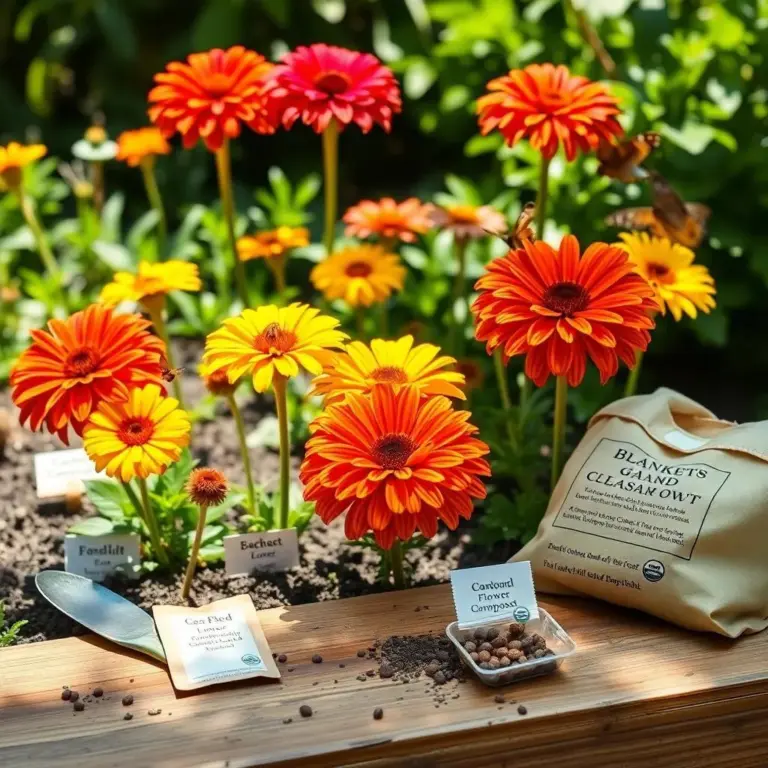Are you ready to add a splash of color to your garden with beautiful blanket flowers? Growing these vibrant blooms from seeds can be so much fun! In this article, I’ll share everything you need to know about their germination process, helpful tips to speed things along, and how to tackle any hiccups you might encounter along the way. Let’s get those seeds sprouting! 🌼
Factors Influencing Blanket Flower Seed Germination
When it comes to growing blanket flowers, understanding the factors that influence seed germination is super important! Trust me, a little knowledge goes a long way in helping those beautiful blooms appear in your garden. So, what should you keep an eye on? Here are the main factors that can affect how quickly your blanket flower seeds sprout:
- Temperature: Seeds are like Goldilocks—they want it just right! The ideal soil temperature for blanket flower seeds is between 70-75°F (21-24°C). If it’s too cold, they might just snooze for a while longer. Too hot, and they may just decide to give up. Keeping things cozy will definitely help.
- Moisture: Seeds need a drink, but not a flood! They like to be kept consistently moist while they germinate. If they dry out, they might stay dormant longer than you’d like. A simple misting now and then can do wonders. Just remember, soggy soil can lead to rotting, and we don’t want that!
- Light: Believe it or not, blanket flower seeds need light to sprout! So, when planting, don’t bury them too deep. Instead, just lightly press them into the soil—like tucking them in for a nap!
- Seed Quality: Fresh seeds are like fresh bread—better quality means better results! Make sure to buy your seeds from a reputable source. Old or damaged seeds might be the reason for your slow germination.
- Scarification: Some seeds need a little extra love before they can sprout. Scarification is like giving them a gentle nudge! Scratching the seed coat helps water get in. Just be careful not to harm the seed inside!
By keeping these factors in mind, you’ll be well on your way to nurturing gorgeous blanket flowers in your garden!
Ideal Conditions for Successful Germination
Now that we understand the factors that influence germination, let’s set the stage for success! Creating the ideal conditions for blanket flower seed germination is like preparing a cozy bed for a good night’s sleep—you want everything just right! Here’s how to do it:
- Soil Type: Blankets flowers love well-draining soil that allows their roots to breathe. Aim for a soil pH between 6.0 and 7.5. Mixing in some compost can really help! It’s like giving your seeds a nutrient-rich smoothie!
- Planting Depth: Don’t bury your seeds too deep—it’s a common mistake! Planting them about 1/8 to 1/4 inch (3-6 mm) below the surface will let them get the light they need. Just press them into the soil gently. Easy peasy!
- Watering: While we talked about moisture before, proper watering is key here! After planting, water lightly but consistently. I like to use a spray bottle—it’s gentle and helps avoid drowning those little guys!
- Light Exposure: Your blanket flower seeds will thrive in full sun. Make sure they get 6-8 hours of direct sunlight daily. If you’re planting indoors, consider using grow lights to keep things bright and sunny!
- Protection: If it’s chilly or windy outside, don’t hesitate to provide a protective covering! A simple plastic sheet can create a mini greenhouse effect, keeping things warm and cozy for your seeds.
With these ideal conditions, your blanket flower seeds will be on their way to sprouting into those vivid blooms we all adore! Remember, gardening is all about patience and love, so give your seeds what they need, and watch the magic happen! 🌼

Steps in the Germination Process for Blanket Flowers
Getting from seed to stunning blanket flower is an exciting journey! Each stage in the germination process is like a little milestone along the way to those beautiful blooms. Here’s a breakdown of what happens when you plant those seeds and what you can expect:
- Preparation: Right after I plant the seeds, they begin their period of preparation. Some seeds might need a little scarification or time in cooler temperatures to wake up from dormancy. Think of it as a cozy nap before the exciting adventure begins!
- Imbibition: This is when the seeds drink up water from the soil. They swell and soften, which wakes up the enzymes inside. It’s like they’re having breakfast, preparing for the big day ahead!
- Radicle Emergence: Next, the radicle, which is the root part of the seed, pushes down into the soil. This is where the seed starts making its home underground!
- Cotyledon Expansion: Soon after, the cotyledons, or first leaves, pop up from the soil. These little leaves provide the seedling with energy until it can start feeding itself through photosynthesis.
- True Leaf Development: As the cotyledons mature, the true leaves emerge. These are the leaves that will soon attract all the sunshine and nutrients needed for healthy growth.
- Root and Shoot Growth: Finally, the root system becomes more established, while the shoot continues to rise toward the light. This stage is where all the magic happens, and you can see your efforts starting to pay off!
Watching these steps unfold is one of the joys of gardening. Just remember, patience is key. Germination can take anywhere from 7 to 21 days, depending on the conditions. So, keep watering and caring for your seeds, and you’ll soon see those beautiful blanket flowers growing in your garden!
Tips for Accelerating Blanket Flower Seed Germination
If you’re anything like me, you might get a little impatient waiting for those seeds to sprout! Luckily, there are several tips and tricks I’ve learned over the years that can help speed up the germination process for your blanket flower seeds. Here’s how to give them the nudge they need:
- Pre-Soaking Seeds: Before planting, try soaking the seeds in room temperature water for about 24 hours. This helps soften the seed coat and kick-starts the germination process!
- Seedling Heat Mat: Using a heat mat can create a warm environment for your seeds, helping them germinate more quickly. Just be sure to follow the instructions and set the right temperature!
- Bottom Watering: Instead of watering from above, place your seed tray in a shallow container of water. This allows the soil to absorb moisture from the bottom without disturbing the seeds.
- Seed Germination Chamber: Creating your own little greenhouse can really help! Cover your trays with a clear plastic dome or use a mini greenhouse. This keeps moisture in and creates a warm, cozy spot for those seeds.
- Provide Optimal Light: If you’re starting indoors, don’t skimp on the light! Use grow lights, aiming for 12-16 hours of light a day. This encourages quick and healthy growth.
- Monitor Moisture Levels: Keep an eye on the soil moisture. It should be consistently moist but not waterlogged. A gentle misting with a spray bottle can help maintain just the right balance.
- Maintain the Right Temperature: Always try to keep the soil temperature within the ideal range of 70-75°F (21-24°C). If it gets too chilly, your seeds might take their time coming up!
By applying these tips, you’ll be amazed at how quickly your blanket flower seeds can germinate and grow! With just a bit of love and attention, you’ll be on your way to a vibrant garden filled with stunning blooms!
How to Address Delayed Germination Issues
Sometimes, despite our best efforts, blanket flower seeds might take longer to sprout than expected. If you find yourself anxiously peering into the soil and wondering, “Where are my flowers?”, here’s how to handle delayed germination issues!
- Patience is Key: First off, take a deep breath! Seeds can be quirky. While they usually germinate in 7-21 days, some may take a bit longer, especially in cooler or less favorable conditions. Give them a little more time!
- Check Environmental Conditions: If it’s been a while, evaluate the conditions. Is the soil temperature within the ideal range? Is the soil staying moist but not soggy? If conditions are off, adjust them to help the seeds wake up!
- Scarify the Seeds: If you suspect that the seed coat might be tough, gently scarify them. Use fine-grit sandpaper or a knife to make a small scratch, and be careful not to hurt the seed inside!
- Provide Bottom Heat: Sometimes giving your seeds a warm boost can do wonders. Place your seed tray on a warm surface or use a seed heating mat to help maintain the right temperature.
- Test Seed Viability: After waiting a few weeks, you might want to test the seeds. Take a few seeds, place them on a damp paper towel, and seal them in a plastic bag. Keep them warm for a few days, and check for signs of germination. If they don’t sprout, it may be time to consider fresh seeds.
- Seed Priming: This fun technique involves soaking seeds in water or a seed-starting solution before planting! It helps prep the seeds for germination and can speed up the process.
- Explore Fresh Seed Sources: If, after all that care, your seeds still refuse to sprout, it might be time to look for fresher seeds from reliable sources!
These strategies will help you handle any hiccups in the germination process. Remember, gardening is filled with surprises, and with a little patience and care, you’ll soon have your blanket flowers blooming beautifully! 🌼

